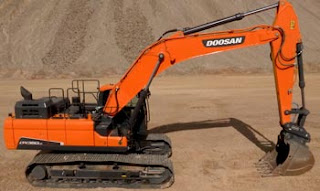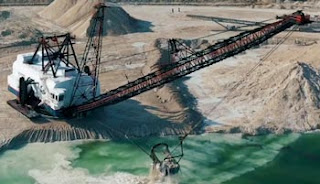Excavation can be defined as disintegration of the earth’s crust by means of machines applying various methods for economic purposes. The task excavation is practiced commonly by excavators. Components of excavator
Excavators are types of mobile digging machines used for heavier construction purposes. Equipped with a hoe, boom, operator cabin, dipper arm, hydraulic actuators and engine compartment.
The hoe, cab and engine compartment made up the upper structure of the excavator which can be rotate up to 360 degree supported by the undercarriage with tracks or wheels enabling the mounted structure to rotate on any direction quickly enough to load a dump truck. Excavators are one of the most efficient and reliable earth mover equipment. It is used to dig trenches, lay pipes and load materials.
Types of excavator
From smaller size skid steers to the large size bucket-wheel excavator there are many types of excavators in the market dealing with demands and applications.We will discuss the common types of excavatorTrack-mounted/crawler excavator: The upper structure is supported by tracked undercarriage which provides greater mobility and flotation on unpaved terrains. Used in rough, muddy landscape excavation.
wheeled excavator: Unlike the crawler excavator the upper structure is supported with wheeled undercarriage enabling easy movement around the excavation site. Equipped with stabilizer for additional stability while performing digging operation. Used in paved terrain and asphalt excavation.
Dragline excavator: Uses hoist-rope-propelled mechanism to conduct digging operation. The dragrope is flown to the axis and the bucket is elongated towards the driver. Used in surface mining, deep harbor excavation.
Working principle of excavator Components of excavator
Excavator uses diesel engine to guarantee maximum performance in heavy duty excavation. The engine powers all the components from hydraulic excavator arm to crawling tracks. The following principle can be divided into three sections.- Power and drive control: The operator uses pedals and levers to position and move the machine forward and backward. The operator’s cab alongside with the upper frame can be rotate up to 360 degrees.
- Excavator arm: The hydraulic excavator arm performs the digging operation. The self-directed mechanical arm has two section and a bucket. The sections are joined by a hinge and is driven by hydraulic pistons that controls the up-down and closer-further movement of the excavator arm.
- Undercarriage: The undercarriage of an excavator delivers mobility and traction, stationed around a series of gear that turn by power received from the driver-shaft enabling the excavator to move around the operation site.
Components of excavator
- Operator’s cabin: It is seen on the left or right side to the boom. It is the location from where an operator controls and monitor the machine. It is tightly sealed to reduce noise, vibration, dust turbulence.
- Bucket loader: Buckets are available in various width, allowing easier dumping while digging operation. The digging edge is equipped with penetration teeth.
- Hydraulic cylinder: It is equipped with rod, piston and hydraulic fluid. When fluid is pumped at the end of the piston, it pushes the rod against the hinge resulting in extend and retracted movement of the boom and dipper arm.
- Hydraulic pump: It converts mechanical energy into hydraulic energy. Mechanical action forces the fluid come from the reservoir to flow to the hydraulic system.
- Boom: An articulated arm section allows the bucket to come closer to the excavator. Permits dipper digging.
- Counterweight: It is important to counterbalance the weight of the excavator itself while carrying heavy load. For this, counterweight is added typically made of concreate/steel slabs at the back of the hoe ensuring distributed weight ratio. Without the counterweight the vehicle can tip over.
- Dipper arm/stick: Dipper arm is connected with the boom with a hinge. The bucket is hinged to the lower’ end of the dipper arm. It allows the bucket teeth to move inward in a digging motion.
- Track frame: Track frame supports the whole structure. Equipped with track chain, roller, idler and grip. It enables the excavator to move around the construction site.
Attachments in excavation techniques
- Auger: Auger are capable to perform most drilling tasks undertaken on various terrains.
- Breaker: Similar to jackhammer, used to breaking stone and concreate.
- Clamp: Allows to pick large material that typically doesn’t fit in bucket.
- Grapple: Also used to picking up large amount of materials particularly from any direction.
- Drum cutters: A mounting additional attachment that can smash through the concreate structure with shear force.






Post a Comment